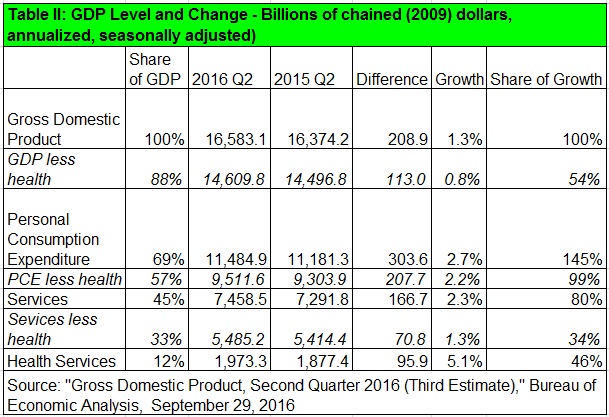GDP: Health Services Grew Almost 12 Times Faster Than Non-Health GDP
 The media noted today’s third estimate of second quarter Gross Domestic Product was revised upward from the second estimate. It was a sharply revised estimate of health spending that led to the higher overall estimate. While the estimate of GDP was revised up by $12.9 billion, the estimate of health services spending was revised up by $16.2 billion. Spending on services other than health services was revised down.
The media noted today’s third estimate of second quarter Gross Domestic Product was revised upward from the second estimate. It was a sharply revised estimate of health spending that led to the higher overall estimate. While the estimate of GDP was revised up by $12.9 billion, the estimate of health services spending was revised up by $16.2 billion. Spending on services other than health services was revised down.
In real (inflation-adjusted) dollars, services grew 2.9 percent (annualized, seasonally adjusted) from the first quarter. As a large component of services, health services grew 7.1 percent. While real GDP growth was 1.4 percent, once health services is stripped out, non-health GDP grew just 0.6 percent.
See Table I below the fold:
Year on year growth tells a similarly grim story, for those concerned with health spending’s takeover of our economy. Real GDP grew 1.3 percent, but health services grew 5.1 percent. Non-health services grew just 1.3 percent, while non-health GDP grew just 0.8 percent (Table II).
The continuing dominance of government and insurers over our health economy is not bending the cost curve.
Technical note: Until the July 29, 2016 entry on the GDP release, I discussed nominal GDP growth. As of August 26, 2016, these updates discuss real GDP growth, in line with the way most media cover GDP.
When I discuss health services in these quarterly GDP releases, I mean only health services. I do not include purchases of medical equipment, or facilities construction. While I include Medicare and Medicaid, I do not include Veterans Health Administration or other government benefits. So, these dollar figures undercount the amount of our economy consumed by the government-health complex.
(See: Measuring the Economy: A Primer on the GDP and the National Income and Product Accounts, Bureau of Economic Analysis, October 2014, pages 5-2 and 5-3; Micah B. Hartman, et al., “A Reconciliation of Health Care Expenditures in the National Health Expenditures Accounts and in Gross Domestic Product,” Research Spotlight, Survey of Current Business, September 2010, pages 42-52.)




John, you write, “those concerned with health spending’s takeover of our economy. – health services grew 5.1 percent. Non-health services grew just 1.3 percent, while non-health GDP grew just 0.8 percent.”
In the future wages will have to drop to zero so all revenue can be devoted to health care.
Vladimir Lenin said, “Socialized medicine is the keystone to the arch of the socialist state.”
Yesterday Hillary nodded her head for 10 minutes straight at her rally in Durham, New Hampshire. As Bernie Sanders spoke, she bobbed her head up and down continuously. This may be a sign of a serious neurological disorder, like Parkinson’s. We deserve to have more information on Hillary’s health. There is no way to defend this:
https://www.youtube.com/watch?v=ZkJnnDLm7dc
The Socialist leader is a BOBBLEHEAD – Vote Trump
Wikiquote:
Socialized medicine is the keystone to the arch of the socialist state.
Fabricated quote from The Voluntary Way is the American Way (1949) by PR firm Whitaker and Baxter. According to The Heart of Power by David Blumenthal and James Morone (pp. 91-92):
Whitaker and Baxter published a fifteen-page pamphlet of questions and answers entitled The Voluntary Way is the American Way, which, deep in the Q&A, concocted a quotation from Lenin:
Q: Would socialized medicine lead to socialization of other phases of American life?
A: Lenin thought so. He declared: socialized medicine is the keystone to the arch of the socialist state.
Senator Murray asked the Library of Congress to track down the quote and, as expected, they found nothing like it—most scholars assume Whitaker and Baxter dreamed it up.
Alternate form: “Socialized medicine is a keystone to the establishment of a socialist state.”
[…] Health Services Grew Almost 12 Times Faster Than Non-Health GDP. Since 2015 the increase in health care spending has resulted in flat retail sales. This health care driven economy is different than the consumer driven economy we have experience with. The health care driven economy has very narrow benefits to the overall economy compared to the consumer driven economy. Based on the GDP numbers over the last year and a half, it looks like we can have either a health care driven economy or a consumer driven economy but not both. […]